A) A
B) B
C) C
D) D
E) E
Correct Answer

verified
Correct Answer
verified
Multiple Choice
Which of the following people used this apparatus to study the formation of organic compounds? 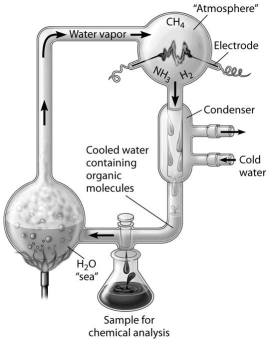
A) Stanley Miller
B) Jakob Berzelius
C) Friedrich Wohler
D) Hermann Kolbe
E) August Kekulé
Correct Answer

verified
Correct Answer
verified
Multiple Choice
Of the biologically important functional groups listed below, which acts as a base?
A) hydroxyl
B) carboxyl
C) amino
D) sulfhydryl
E) methyl
Correct Answer

verified
Correct Answer
verified
Multiple Choice
Which of the pairs of molecular structures shown below depict enantiomers (enantiomeric forms) of the same molecule?
A) ![]()
B) ![]()
C) ![]()
D) ![]()
E) ![]()
Correct Answer

verified
Correct Answer
verified
Multiple Choice
Hydrocarbons are ________ because most of their bonds are ________ carbon-hydrogen links.
A) hydrophilic; polar
B) hydrophilic; charged
C) hydrophobic; polar
D) hydrophobic; non-polar
E) inorganic; not
Correct Answer

verified
Correct Answer
verified
Multiple Choice
Which two functional groups are always found in amino acids?
A) ketone and methyl
B) carbonyl and amino
C) carboxyl and amino
D) amino and sulfhydryl
E) hydroxyl and carboxyl
Correct Answer

verified
Correct Answer
verified
Multiple Choice
Use the following figure to answer the questions below.
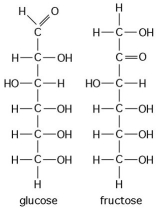 -The figure above shows the structures of glucose and fructose. These two molecules differ in the
-The figure above shows the structures of glucose and fructose. These two molecules differ in the
A) number of carbon, hydrogen, and oxygen atoms.
B) types of carbon, hydrogen, and oxygen atoms.
C) arrangement of carbon, hydrogen, and oxygen atoms.
D) number of oxygen atoms joined to carbon atoms by double covalent bonds.
E) number of carbon, hydrogen, and oxygen atoms; the types of carbon, hydrogen, and oxygen atoms; and the arrangement of carbon, hydrogen, and oxygen atoms.
Correct Answer

verified
Correct Answer
verified
Multiple Choice
Hermann Kolbe's synthesis of an organic compound, acetic acid, from inorganic substances that had been prepared directly from pure elements, was a significant milestone for what reason?
A) It solved an industrial shortage of acetic acid.
B) It proved that organic compounds could be synthesized from inorganic compounds.
C) It disproved the concept of vitalism.
D) It showed that life originated from simple inorganic chemicals.
E) It proved that organic compounds could be synthesized from inorganic compounds and disproved the concept of vitalism.
Correct Answer

verified
Correct Answer
verified
Multiple Choice
Use the following figure to answer the questions below.
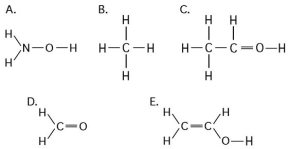 -Which of the structures illustrated above is an impossible covalently bonded molecule?
-Which of the structures illustrated above is an impossible covalently bonded molecule?
A) A
B) B
C) C
D) D
E) E
Correct Answer

verified
Correct Answer
verified
Multiple Choice
Use the following information to answer the questions below.
You are investigating the differences between three organic compounds. They all have the same carbon skeleton but have differences in their functional groups.
-Which functional group is not present in this molecule? 
A) carboxyl
B) sulfhydryl
C) hydroxyl
D) amino
Correct Answer

verified
Correct Answer
verified
Multiple Choice
Which of the following statements best describes the carbon atoms present in a seed-eating bird?
A) Inorganic carbon atoms in the seeds were incorporated into organic molecules by the bird.
B) The carbon atoms ultimately came from the soil.
C) The carbon atoms are ultimately derived from coal.
D) The carbon atoms ultimately came from carbon dioxide incorporated into sugars through photosynthesis.
E) The carbon atoms ultimately came from simple organic compounds that formed abiotically from inorganic carbon, hydrogen, oxygen, and nitrogen atoms.
Correct Answer

verified
Correct Answer
verified
Multiple Choice
How many electron pairs does carbon share in order to complete its valence shell?
A) 1
B) 2
C) 3
D) 4
E) 8
Correct Answer

verified
Correct Answer
verified
Multiple Choice
Organic molecules with only hydrogens and five carbon atoms can have different structures in all of the following ways except
A) by branching of the carbon skeleton.
B) by varying the number of double bonds between carbon atoms.
C) by varying the position of double bonds between carbon atoms.
D) by forming a ring.
E) by forming enantiomers.
Correct Answer

verified
Correct Answer
verified
Multiple Choice
Use the following figure to answer the questions below.
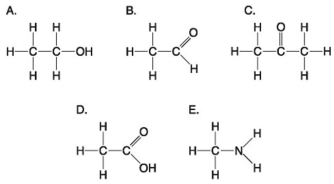 -Which molecule shown above has a carbonyl functional group in the form of an aldehyde?
-Which molecule shown above has a carbonyl functional group in the form of an aldehyde?
A) A
B) B
C) C
D) D
E) E
Correct Answer

verified
Correct Answer
verified
Multiple Choice
Use the following figure to answer the questions below.
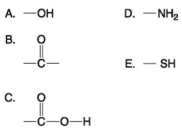 -Which of the groups above is a basic functional group that can accept H⁺ and become positively charged?
-Which of the groups above is a basic functional group that can accept H⁺ and become positively charged?
A) A
B) B
C) C
D) D
E) E
Correct Answer

verified
Correct Answer
verified
Multiple Choice
Use the following figure to answer the questions below.
 -Which molecule shown above contains a carboxyl group?
-Which molecule shown above contains a carboxyl group?
A) A
B) B
C) C
D) D
E) E
Correct Answer

verified
Correct Answer
verified
Multiple Choice
Which of the following people was the first to synthesize an organic compound, urea, from inorganic starting materials?
A) Stanley Miller
B) Jakob Berzelius
C) Friedrich Wohler
D) Hermann Kolbe
E) August Kekulé
Correct Answer

verified
Correct Answer
verified
Multiple Choice
Use the following figure to answer the questions below.
 -In which of the structures illustrated above are the atoms bonded by ionic bonds?
-In which of the structures illustrated above are the atoms bonded by ionic bonds?
A) A
B) B
C) C
D) C, D, and E only
E) none of the structures
Correct Answer

verified
Correct Answer
verified
Multiple Choice
Which of the pairs of molecular structures shown below do NOT depict enantiomers (enantiomeric forms) of the same molecule?
A) ![]()
B) ![]()
C) ![]()
D) ![]()
E) ![]()
Correct Answer

verified
Correct Answer
verified
Multiple Choice
Answer the following questions based on the figure below.
 -Identify the asymmetric carbon in this molecule.
-Identify the asymmetric carbon in this molecule.
A) A
B) B
C) C
D) D
E) E
Correct Answer

verified
Correct Answer
verified
Showing 21 - 40 of 78
Related Exams